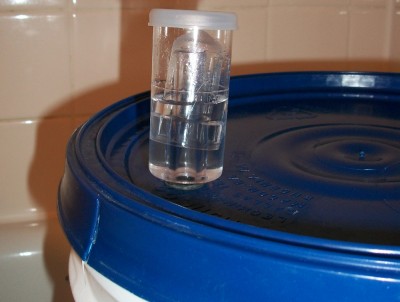 How Long Does Fermentation Take To Start?
How Long Does Fermentation Take To Start?
I remember my first batch of homemade beer. I brewed it, pitched the yeast, put the lid on the white bucket, put on the blue lid and topped it off with an airlock. I put it away in the closet, closed the door and immediately started wondering how long it would take for the fermentation to start. I saw videos online of airlocks filled with bubbles, I wanted to know when my airlock would have the same activity.
The answer is that it’s going to take at least 12-36 hours for the yeast to start showing signs of fermentation.
Before the yeast even start turning your wort into beer, they go through a phase called respiration. I know, it reminds me of high school biology too and I would’ve paid more attention if the course materials included making beer.
Respiration lasts between 4-8 hours and there won’t be much for you to see during this period. According to Charlie Papazian in The Complete Joy Of Homebrewing it’s during this period where the yeast gain and store energy for future activities and reproduction.
After respiration is complete, you’ll start to see some action. This is the fermentation, where the yeast turn the sugars in the wort to alcohol.
The exact time varies because of these factors:
- Temperature: If you’re yeast are too cold, they’re going to work slower. If they’re warmer, they’re going to work faster, just make sure the yeast aren’t too hot. If the temperature is too high in the fermenting bucket, it could lead to some problems in the final product. Make sure you keep your beer within the recommended rage on the yeast packaging or in the recipe.
- Oxygen Levels: The more oxygen in your wort, the happier the yeast will be and the faster they’ll work. Make sure you properly oxygenate your wort before pitching the yeast.
- Type Of Yeast: Some yeast types work faster than others based on their natural metabolism. However, you can’t just change to a different kind of yeast to get faster results. You need a specific type of yeast to get a specific style of beer. However, you can create a yeast starter to see better results quicker.
- Amount Of Yeast: If there’s not enough yeast, they’re going to have to spend more time reproducing instead of fermenting your wort. This goes back to the last factor and creating a yeast starter. Some yeast and some recipes need a starter.
- High Gravity Beers: The more fermentable sugars in the wort, means that there’s more work for the yeast to do. Higher gravity beers may need a yeast starter.
- Water: For more beginner to intermediate homebrewers, you won’t have to worry about your water. However, once you get into the more technical aspecits of brewing, you may want to take control of your water if it has high levels of pH, minerals, etc because they can affect the yeast, among other aspects of the beer.
If you don’t see any activity within the 12-36 hour window, don’t start worrying yet! Relax and have a beer instead. Then do a gravity reading and see if the levels have changed since you to the original gravity reading.
According to the yeast manufacturer Wyeast Laboratories, if you don’t see a gravity change, you should make sure the temperature is warm enough for the yeast, then shake the bucket or carboy to see if that will bring the yeast to life.
If there’s still no signs of life after 12 hours, it might be time to run to the local homebrew shop and pick up a new pack of yeast.
A similar question you might have is:
I Don’t See Any Bubbles Or Activity In The Airlock Is My Beer Fermenting?
Check out this blog post: Airlock Questions Answered: No Bubbles? Bubbling Done?
—
Stay up to date with Passion For The Pint via Facebook, Twitter or subscribing to the newsletter (and free homebrew ecourse).
I sometimes assist my dad when he homebrews. When we finally bottle the stuff, there’s really not much action in it at all. So we add a little more sugar in the bottling process. It still seems to take a while to ferment while in the bottle. We never can seem to get a real decent head with good retention.
Just make sure you don’t add too much sugar! LOL, I’ve done that when I was getting impatient and the results weren’t pretty when they overflowed with foam when they finally carbed.
We’ve had that problem in older batches. A few bottles have blown their tops off.
1 oz of corn sugar per gallon. Leave an inch top of bottle for expansion before capping.
I have just made an all grain brew last night and don’t have any action at the minute, been around 12 hours, I used two 11g packets for 50litres, should that be enough?
As long as the wort is 70 or below, and the yeast
is fresh. It should kick in within 24 hours, sometimes longer. After 36-48 hours, get some more yeast and pitch it again.
All good tips! I always pre-activate my yeast with a starter.
Something to note on free oxygen levels, in ‘brewing’ yeast only use free oxygen during their initial aerobic (with oxygen) respiration phase to build up ATP energy stores, once the oxygen is depleted the yeast switches to the anaerobic (lack of oxygen) fermentation phase and actually produces the desired alcohol. This is why it’s important to introduce free oxygen right before pitching the yeast, but also equally important to deprive the yeast of any additional free oxygen at some point so that the yeast creates the desired alcohol and doesn’t eat through the sugars simply stockpiling it’s ATP energy reserves, as it would do if not deprive of free oxygen.